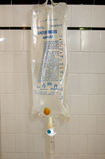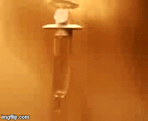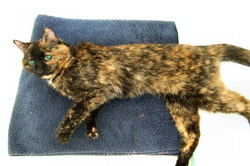How to Administer subcutaneous hydrating fluids to an ailing Cat
Hydrating an ailing cat with subcutaneous fluids may become necessary if it refuses to drink. If the 'patient' refuses water, even with ice cubes added, you may need a more drastic approach. Without adequate hydration, a weak animal has no chance for recovery. An animal (and humans) can survive longer without food than water. You can check for dehydration by pulling up on the skin then releasing it. If it is slow to snap back, the animal is dehydrated.
When dehydration occurs, any waste matter accumulated in the bowels can harden and cease to pass. Such constipation can twist the bowel or cause bowel obstruction. Intestinal blockage can further lead to ileus, ruptured bowel leading to overwhelming infection, organ failure and painful death.
As a recovery or preventive measure, fluids may need to be administered subcutaneously. A Veterinarian will use and recommend Lactated Ringer (LR). LR contains Sodium Chloride, Sodium Lactate, Anhyd, Potassium Chloride, Calcium Chloride and Water. It hydrates while providing electrolytes. The subcutaneous injection is administered just under the skin. Do not inject LR directly into muscle tissue or veins.
Things You'll Need:
* 1000 mL bag of Lactated Ringers solution w/ plumbing
When dehydration occurs, any waste matter accumulated in the bowels can harden and cease to pass. Such constipation can twist the bowel or cause bowel obstruction. Intestinal blockage can further lead to ileus, ruptured bowel leading to overwhelming infection, organ failure and painful death.
As a recovery or preventive measure, fluids may need to be administered subcutaneously. A Veterinarian will use and recommend Lactated Ringer (LR). LR contains Sodium Chloride, Sodium Lactate, Anhyd, Potassium Chloride, Calcium Chloride and Water. It hydrates while providing electrolytes. The subcutaneous injection is administered just under the skin. Do not inject LR directly into muscle tissue or veins.
Things You'll Need:
* 1000 mL bag of Lactated Ringers solution w/ plumbing
 Lactated Ringers Lactated Ringers
1. Hang the 1000 mL bag above the level of the cat. This allows for gravity feed. Make sure that you can easily see the graduated measurements and reach the open/shut line valve. Be sure to have a fresh/sterile needle securely attached to the end of the drip line. Observe the drip chamber, before administering the dosage. If it is filled with liquid invert the bag then squeeze & release the chamber. After returning the bag to the upright position, the chamber should only fill part way.
 Target window
2. Position the cat comfortably so that you have easy parallel access to the 3 inch square "target window" of loose skin located directly over the shoulder blades. It may help to lay the cat on a folded towel. You may find it necessary to wrap the cat loosely in the towel to help calm or restrain it. Try your best to make this experience pleasant and avoid stressing the patient. Avoid as much discomfort as possible, by running the drip line down your back, inside of your clothing. Sit back against the chair or couch, to establish good skin contact. This warms the room temperature fluid as it passes through the line, and prevents lowering the patients core temperature.
 Preparation
3. Grab and pull upwards enough loose skin, using your thumb, index and middle finger, so that your finger tips remain about 1-1/2 inches above any bone or muscle tissue.
 Administering fluids
4. Insert the needle parallel to the back and below your index finger tip. Veterinarians recommend having a shallow angle rather than a steep one, to prevent hitting bone or muscle. You must keep the cat from moving during this process. Grasping the drip line gently with a bit of fur will keep the needle from moving around excessively or from sliding out.
 I.V. Drip Chamber I.V. Drip Chamber
5. Keeping an eye on the liquid levels start and stop increments, fully open the line valve and observe a steady flow of liquid in the drip chamber located just below the bag. At a drip per second, 50 mL should take approximately 14 minutes. Check for leakage. If you accidentally penetrated through and through, pull the needle out just far enough that the tip remains under the skin.
 Fluid accumulation
6. Keep a watchful eye as the LR level drops near to the desired mark. As fluid accumulates under the skin, it will form a small sack similar to a very small weak water balloon. Recommended dosage for a typical house cat of between 5-7 pounds is approximately 50-75 mL, after an initial dose normally about 100 mL. Close the line valve to stop the flow. Place a finger tip over the injection site and withdraw the needle, in a smooth motion. Keep a slight pressure for a minute or so. A very small amount of blood-tinged fluid may leak out.
Tips
* Schedule the drip as the last task, after bathing, feeding and medicating so that the Cat may rest as the fluids gradually dissipate. * The initial dosage in this particular instance was 100 mL. Subsequent dosages recommended to be between 50-75 mL are to be administered every 24 hours. * You may find it helpful to mark the increments with a red Sharpie. * LR solution also comes in smaller 100mL bags. Your Vet may recommend this size, since it is common Hospital practice for open bags of LR to be replaced after 72 hours. * Always follow the instructions as directed by your Veterinarian, as dosages and conditions will differ. Warnings * Always replace a used needle, to reduce chance of infection. * Do not refrigerate, administer at room temperature. Cold fluids under the skin cause pain and discomfort. * Do not apply pressure to the bag to force the flow, allow a gravity feed. * Do not apply pressure to the liquid accumulated under the skin, allowing it to dissipate slowly and naturally. * It is ultimately easier to prevent dehydration than it is to recover from it! Copyright 09/17/2009 All Rights Reserved. Questions? Comments? Contact Me Related article: Pet |
|
